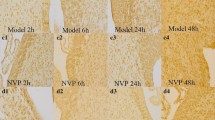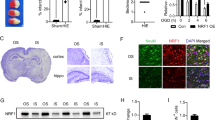Abstract
Hypoxia in neonates can cause permanent brain damage by gene and receptor level alterations mediated through changes in neurotransmitters. The present study evaluated GABAB receptor alterations, gene expression changes in glutamate decarboxylase and hypoxia-inducible factor 1A in the cerebral cortex of hypoxic neonatal rats and the resuscitation groups with glucose, oxygen, and epinephrine. Under hypoxic stress, a significant decrease in total GABA and GABAB receptors, GABAB and GAD gene expression was observed in the cerebral cortex, which accounts for the respiratory inhibition. Hypoxia-inducible factor 1A was upregulated under hypoxia to maintain body homeostasis. Hypoxic rats supplemented with glucose alone and with oxygen showed a reversal of the receptor alterations and changes in GAD and HIF-1A to near control. Being a source of immediate energy, glucose can reduce the ATP-depletion-induced changes in GABA and oxygenation, which helps in encountering hypoxia. Resuscitation with oxygen alone and epinephrine was less effective in reversing the receptor alterations. Thus, our study suggests that reduction in the GABAB receptors functional regulation during hypoxia plays an important role in cortical damage. Resuscitation with glucose alone and glucose and oxygen to hypoxic neonatal rats helps in protecting the brain from severe hypoxic damage.




Similar content being viewed by others
References
Mishra OP, Fritz KI, Delivoria-Papadopoulos M (2001) NMDA receptor and neonatal hypoxic brain injury. Ment Retard Dev Disabil Res Rev 7:249–253
Neubauer JA, Melton JE, Edelman NH (1990) Modulation of respiration during brain hypoxia. J Appl Physiol 68:441–451
Weil JV, Zwillich CW (1976) Assessment of ventilatory response to hypoxia. Chest 70(1):124–128
Kneussl MP, Pappagianopoulos P, Hoop B, Kazemi H (1986) Reversible depression of ventilation and cardiovascular function by ventriculocisternal perfusion with γ-aminobutyric acid in dogs. Am Rev Respir Dis 133:1024–1028
da Silva AMT, Hartley B, Hamosh P, Quest JA, Gillis RA (1987) Respiratory depressant effects of GABA α- and β-receptor agonists in the cat. J Appl Physiol 62:2264–2272
Kazemi H, Hoop B (1991) Glutamic acid and gamma-aminobutyric acid neurotransmitters in central control of breathing. J Appl Physiol 70:1–7
Richter DW, Schmidt-Garcon P, Pierrefiche O, Bischoff AM, Lalley PM (1999) Neurotransmitters and neuromodulators controlling the hypoxic respiratory response in anaesthetized cats. J Physiol 514:567–578
Di Pasquale E, Morin D, Monteau R, Hilaire G (1992) Serotonergic modulation of the respiratory rhythm generator at birth: an in vitro study in the rat. Neurosci Lett 143:91–95
Neylon M, Marshall JM (1991) The role of adenosine in the respiratory and cardiovascular response to systemic hypoxia in the rat. J Physiol 440:529–545
Elnazir B, Marshall JM, Kumar P (1996) Postnatal development of the pattern of respiratory and cardiovascular response to systemic hypoxia in the piglet: the roles of adenosine. J Physiol 492:573–585
Gozal D, Simakajornboon N, Czapla MA, Xue YD, Gozal E, Vlasic V, Lasky JA, Liu JY (2000) Brainstem activation of platelet-derived growth factor-β receptor modulates the late phase of the hypoxic ventilatory response. J Neurochem 74:310–319
Simakajornboon N, Kuptanon T (2005) Maturational changes in neuromodulation of central pathways underlying hypoxic ventilatory response. Respir Physiol Neurobiol 149:273–286
Zhang W, Barnbrock A, Gajic S, Pfeiffer A, Ritter B (2002) Differential ontogeny of GABAB-receptor-mediated pre- and postsynaptic modulation of GABA and glycine transmission in respiratory rhythm-generating network in mouse. J Physiol 540:435–446
Suzuki M, Tetsuka M, Endo M (1999) GABA(B) receptors in the nucleus tractus solitarii modulate the carotid chemoreceptor reflex in rats. Neurosci Lett 260:21–24
Yang A-L, Lo M-J, Ting H, Chen J-S, Huang C-Y, Lee S-D (2007) GABAA and GABAB receptors differentially modulate volume and frequency in ventilatory compensation in obese Zucker rats. J Appl Physiol 102:350–357
Paul SAM, Simons JW, Mabjeesh NJ (2004) HIF at the crossroad between ischemia and carcinogenesis. J Cell Physiol 200:20–30
Wang GB, Wang XQ, Luo GX, He WF, Chen XW, Wu J, Bian XW (2007) Design of a multifunction medical experiment platform and its temperature regulation in cell in vitro culture. J Third Mil Med Univ 29:1289–1292
Laroia N, McBride L, Baggs R, Guillet R (1996) Dextromethorphan ameliorates effects of neonatal hypoxia on brain morphology and seizure threshold in rats. Dev Brain Res 100:29–34
Turner CP, Seli M, Ment L, Stewart W, Yan H, Johansson B, Fredholm BB, Blackburn M, Rivkees SA (2003) A1 adenosine receptors mediate hypoxia-induced ventriculomegaly. Proc Natl Acad Sci USA 100:11718–11722
Schwartz ML, Vaccarino F, Chacon M, Yan WL, Ment LR, Stewart WB (2004) Chronic neonatal hypoxia leads to long term decreases in the volume and cell number of the rat cerebral cortex. Semin Perinatol 28:379–388
Khokhlova VA, Kazakova PB (1979) Effect of maternal hypoxia on neurogenesis of the cerebral cortex of the progeny in rats (autoradiographic study). Bull Exp Biol Med 87:512–514
Glowinski J, Iversen LL (1966) Regional studies of catecholamines in the rat brain: the disposition of [3H] Norepinephrine, [3H] DOPA in various regions of the brain. J Neurochem 13:655–669
Kurioka S, Toshiaki K, Makoto M (1981) Effects of sodium and bicarbonate ions on gamma amino butyric acid receptor binding in synaptic membranes of rat brain. J Neurochem 37:418–421
Lowry OH, Rosebrough NJ, Farr AL, Randall J (1951) Protein measurement with folin phenol reagent. J Biol Chem 193:265–275
Scatchard G (1949) The attractions of proteins for small molecules and ions. Ann NY Acad Sci 51:660–672
Cheng Y, Prusoff WH (1973) Relationship between the inhibition constant and the concentration of an inhibitor that cause a 50% inhibition of an enzymatic reaction. Biochem Pharmacol 22:3099–3108
Volpe JJ (1990) Brain injury in the premature infant: is it preventable? Pediatr Res 27:S28–S33
Saigal S (2000) Follow-up of very low birthweight babies to adolescence. Semin Neonatol 5:107–118
Rothblat LA, Hayes LL (1982) Age-related changes in the distribution of visual callosal neurons following monocular enucleation in the rat. Brain Res 246:146–149
Olavarria J, Van Sluyters RC (1985) Organization and postnatal development of callosal connections in the visual cortex of the rat. J Comp Neurol 239:1–26
Ferrer I, Soriano E, del Rio JA, Alcantara S, Auladell C (1992) Cell death and removal in the cerebral cortex during development. Prog Neurobiol 39:1–43
Dobbing J (1972) Undernutrition and the developing brain. The relevance of animal models to the human problem. Bibl Nutr Diet 17:35–46
Homayoun K (2006) Midbrain neurotransmitters in acute hypoxic ventilatory response. Adv Exp Med Biol 580:223–226
Huang J, Suguihara C, Hehre D, Lin J, Bancalari E (1994) Effects of GABA receptor blockage on the respiratory response to hypoxia in sedated newborn piglets. J Appl Physiol 77:1006–1010
Jiang BH, Semenza GL, Bauer C, Marti HH (1996) Hypoxia-inducible factor 1 levels vary exponentially over a physiologically relevant range of O2 tension. Am J Physiol 271:C1172–C1180
Louzoun-Kaplan V, Zuckerman M, Perez-Polo JR, Golan HM (2008) Prenatal hypoxia down regulates the GABA pathway in newborn mice cerebral cortex; partial protection by MgSO4. Int J Dev Neurosci 26:77–85
Car H, Oksztel R, Nadlewska A, Konstanty W (2001) Baclofen prevents hypoxia-induced consolidation impairment for passive avoidance in rats. Pharmacol Res 44:329–335
Fearon IM, Zhang M, Vollmer C, Nurse CA (2003) GABA mediates autoreceptor feedback inhibition in the rat carotid body via presynaptic GABAB receptors and TASK-1. J Physiol 553:83–94
Hattori H, Wasterlain CG (2004) Posthypoxic glucose supplement reduces hypoxicischemic brain damage in the neonatal rat. Ann Neurol 28:122–128
Vannucci SJ, Hagberg H (2004) Hypoxia-ischemia in the immature brain. J Exp Biol 207:3154–3749
Lemus M, Montero S, Cadenas JL, Lara JJ, Tejeda-Chávez HR, Álvarez-Buylla R, de Álvarez-Buylla ER (2008) GabaB receptors activation in the NTS blocks the glycemic responses induced by carotid body receptor stimulation. Auton Neurosci 141:73–82
Lauren LJ, Cheung P-Y, Obaid L, Emara M, Johnson ST, Bigam DL, Todd KG (2008) Persistent neurochemical changes in neonatal piglets after hypoxia–ischemia and resuscitation with 100%, 21% or 18% oxygen. Resuscitation 77:111–120
Bandyopadhyay U, Das D, Ranajit K, Banerjee V (1999) Reactive oxygen species: oxidative damage and pathogenesis. Curr Sci 77:658–666
Anju TR, Athira B, Paulose CS (2009) Superoxide dismutase functional regulation in neonatal hypoxia: effect of glucose, oxygen and epinephrine. Indian J Biochem Biophys 46:166–171
Matharan TS, Laemmel E, Duranteau J, Vicaut E (2004) After hypoxia and glucose depletion causes reactive oxygen species production by mitochondria in HUVEC. Am J Physiol Regul Integr Comp Physiol 287:R1037–R1043
Temesvari P, Karg E, Bódi I, Németh I, Pintér S, Lazics K (2001) Impaired early neurologic outcome in newborn piglets reoxygenated with 100% oxygen compared with room air after pneumothorax-induced asphyxia. Pediatr Res 49:812–819
Munkeby BH, Borke WB, Bjornland K, Sikkeland LL, Borge GL, Halvorsen BH (2004) Resuscitation with 100% O2 increases cerebral injury in hypoxemic piglets. Pediatr Res 56:783–790
Shimabuku R, Ota A, Pereyra S, Veliz B, Paz E, Nakachi G (2005) Hyperoxia with 100% oxygen following hypoxia–ischemia increases brain damage in newborn rats. Biol Neonate 88:168–171
Chathu F, Krishnakumar A, Paulose CS (2008) Acetylcholine esterase activity and behavioral response in hypoxia induced neonatal rats: effect of glucose, oxygen and epinephrine supplementation. Brain Cogn 68:59–66
Binoy J, Nandhu MS, Paulose CS (2009) Dopamine D(1) and D(2) receptor functional down regulation in the cerebellum of hypoxic neonatal rats: neuroprotective role of glucose and oxygen, epinephrine resuscitation. Pharmacol Res. doi:10.1016/j.phrs.2009.08.007
Karacaoglu E, Bayram I, Celiköz B, Zienowicz RJ (2007) Does sustained epinephrine release trigger a hypoxia-neovascularization cascade? Plast Reconstr Surg 119:858–864
Jensen A, Künzel W, Kastendieck E (2009) Epinephrine and norepinephrine release in the fetus after repeated hypoxia. J Perinat Med 10:109–110
Dehne N, Hintereder G, Brüne B (2010) High glucose concentrations attenuate hypoxia-inducible factor-1 alpha expression and signaling in non-tumor cells. Exp Cell Res 6:1179–1189
Gao W, Ferguson G, Connell P, Walshe T, Murphy R, Birney YA, O’Brien C, Cahill PA (2007) High glucose concentrations alter hypoxia-induced control of vascular smooth muscle cell growth via a HIF-1 alpha-dependent pathway. J Mol Cell Cardiol 42:609–619
Soulier V, Peyronnet J, Pequignot JM, Cottet-Emard JM, Lagercrantz H, Dalmaz Y (1997) Long-term impairment in the neurochemical activity of the sympathoadrenal system after neonatal hypoxia in the rat. Pediatr Res 42:30–38
Peterson BS (2003) Brain imaging studies of the anatomical and functional consequences of preterm birth for human brain development. Ann NY Acad Sci 1008:219–237
Lindahl E, Michelsson K, Helenius M, Parre M (1988) Neonatal risk factors and later neurodevelopmental disturbances. Dev Med Child Neurol 30:571–589
Berg AT (1988) Childhood neurological morbidity and its association with gestational age, intrauterine growth retardation and perinatal stress. Paediatr Perinat Epidemiol 2:229–238
Casolini P, Zuena AR, Cinque C (2005) Sub-neurotoxic neonatal anoxia induces subtle behavioural changes and specific abnormalities in brain group-I metabotropic glutamate receptors in rats. J Neurochem 95:137–145
Acknowledgments
This work was supported by the research grants from DBT, DST, ICMR, Govt. of India and KSCSTE, Govt. of Kerala to Dr. C. S. Paulose. T. R. Anju thanks Council of Scientific and Industrial Research for Senior Research Fellowship.
Author information
Authors and Affiliations
Corresponding author
Rights and permissions
About this article
Cite this article
Anju, T.R., Abraham, P.M., Antony, S. et al. Alterations in cortical GABAB receptors in neonatal rats exposed to hypoxic stress: role of glucose, oxygen, and epinephrine resuscitation. Mol Cell Biochem 343, 1–11 (2010). https://doi.org/10.1007/s11010-010-0491-9
Received:
Accepted:
Published:
Issue Date:
DOI: https://doi.org/10.1007/s11010-010-0491-9




